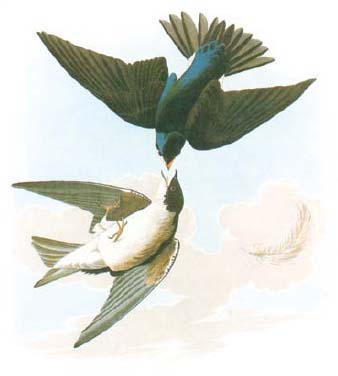

Family: Hirundinidae
Popular and common variants / subspecies / other names: Barn swallow, bank swallow, purple martin
Geographic distribution: Swallows are found on all continents except Antarctica.
Environment: Swallows prefer open habitats, such as grasslands, meadows, and marshes. Being near water appeals to them.
Physical description: The most identifying physical attribute of a swallow is the long tail, which is sometimes forked and sometimes squared. They have short bills, but strong jaws that open wide. Most swallows are dark blue or green above and pale on their undersides. The barn swallow, perhaps the most common swallow in North America, measures about 7 inches long, has a wingspan of about 12 inches, and a weight of just over half an ounce.
Interesting facts: In constant motion, the swallow displays a seemingly erratic flight that results from chasing airborne insects.
Myths, folklore, and cultural associations: A legend tells that the Christ child was once playing in the mud, making little bird shapes that came to life as swallows. People once believed that swallows hibernated in mud by or under water during the winter; not until the end of the nineteenth century did ornithologists agree that swallows instead migrated.
The swallow is said to have flown about Christ on the cross, crying “Cheer up! Cheer up!” In Christian symbolism, the swallow’s return each spring represents the Resurrection.
Swallows spied at sea are a good omen, as their presence means land is near. To kill one is bad luck, or will cause a rainy season; to step on an egg will render a woman infertile; and to disturb a nest will ruin crops. The swallow is also a symbol of freedom, as it does not survive well in captivity.
The swallow’s courage is notable: it will attack humans that come too near its nest, which can be problematic because certain types of swallows like to build nests in house eaves. Folklore decrees that a swallow’s nest built on your house is a lucky thing, and the swallow will protect your home from fires or storm damage. On the other hand, a flock of swallows landing on your roof was said to warn of upcoming poverty. A bird in the house is generally considered a bad omen, however, it is said that a swallow in your home brings good luck.
Omens and divinatory meaning: Swallows are well known for their seemingly overnight return in spring. This abrupt return is a sign of hope and renewal. Seeing a swallow tells you that there is a sudden reversal for the good in your future. The swallow’s sudden return is also a symbol of rapid change in general. Watch for things to happen quickly in your life.
The abundance of folklore about swallows nesting in or near houses also makes the swallow a symbol of hearth and home. If you sight a swallow, think about what it may be telling you about your home. Do you love your home and identify with it? Is it safe? Does it provide spiritual renewal, or is it just a place to crash when you aren’t somewhere else? Take a good look at your home and what it means to you, and take steps to make it as positive a place as you can.
Associated energies: Hope, cycles, renewal, hearth and home, courage
Associated season: Spring
Element association: Air
Color associations: Blue, green, cream, rust, brown